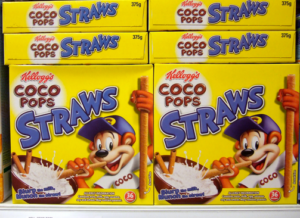
Studies have shown that children are much more likely to reach for foods that have attractive, child friendly packaging whether that be a healthy bag of apples or a burger.
However, ensuring that your packaging is eye catching those young minds is what many brands fail to do.
If you’re launching a product that is aimed toward the curious cerebrum of a little cherub, then take a look at our guide to child friendly packaging below.
Be a Purple Cow

Author Seth Godin has the perfect analogy for attracting the attention of your target audience, he states that if you’re driving down a road, counting the brown cows as you go then eventually you’ll lose interest and the brown cows will mould into the background. However, if you suddenly spot a purple cow then your attention is immediately drawn to the sight, in spite of the thousands of brown cows surrounding it.
In short, it’s all about being unique. Children react well to enthusiasm and if they see confidence and excitement coming across in your brand, then they’ll definitely be drawn in your direction.
Include Imagery but Don’t Ignore Information
According to a study by the University of Pennsylvania, children do prefer cereals that include a cartoon character on the packaging and not just the colourful and creative branding but the taste too.
This phenomenon is commonly known as sensation transference, where the mind associates its initial enjoyment of the packaging onto the taste of the substance inside, and for this reason it’s important to include colours and characters on the packaging itself.
However, while information does take a back seat when it comes child friendly packaging, that doesn’t mean it shouldn’t be included or shrunk to a point where it’s almost impossible to read. Children will point and shout for their favourite colour or character, but it’s the parents who take it to the till.
For this reason, ensure that your nutritional and branding information is clear and concise in order to instil trust in the parents who are considering the purchase.
Make Your Brand 3 Dimensional
No, not in the ‘wear annoying glasses in the cinema’ sense, but more so the idea of not just inventing an image that you can pop on the front of your product, but creating a character who has its own story and life that a child can follow.
While the colourful imagery may work on a one time basis, a food packaging design that comes with its own story or narrative will entice excitement for another instalment.
Many companies nowadays actually license old TV characters that still have modern day appeal, it’s a simple way to really build a back story for your brand and as long as the character isn’t doing anything that would be considered outside its traditional narrative, then you’re good to go.

Keep up the Consistency
Whether you’re only pushing one product, or you have a series of stock that you’re hoping will be a hit with a young audience, consistency is key to cracking your target market.
While many would easily recognise the ‘Coco Pops’ monkey, the brand uses the same colour scheme and font in order to guarantee recognition across it’s numerous different products.
Children will recognise the same patterns and so a sudden change of font or colour pallette may lead to your target audience failing to find its favourite brand.
For this reason it’s important to find a packaging design that you’re comfortable with long term in order to avoid the issue of having to rebrand, and possibly lose customers later on.

Read More
If you’d like more hints and ideas on how to create the perfect packaging, or how certain products could help you, take a look at a few of our blogs below.
Colour Psychology: The Use of Colour in Packaging and Branding
Sustainable Packaging: How Your Company Can Help the Environment
